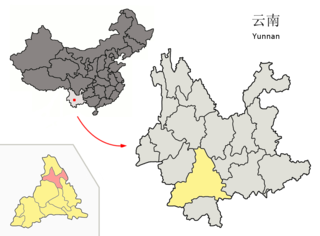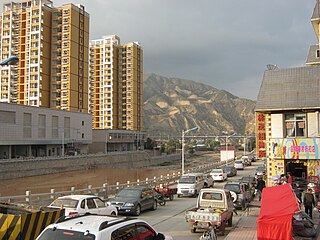Guichi District is a district of the city of Chizhou, Anhui province, People's Republic of China and the seat of the city government. The district has a population of 630,000 and an area of 2,432 km2 (939 sq mi).
Gold Typhoon Group is a Chinese entertainment company. Gold Label was founded in 2003 in Hong Kong, launched with the support of EMI, and acquired EMI Music Taiwan / EMI Music China in 2008, reforming to Gold Typhoon. On 1 January 2011, it became a wholly owned subsidiary of Pacific Global Management Asia (PGMA) under the leadership of Chairman Louis Pong.
Ethnic townships, ethnic towns, and ethnic sumu are fourth-level administrative units designated for ethnic minorities of political divisions in China. They are not considered to be autonomous and do not enjoy the laws pertaining to the larger ethnic autonomous areas such as autonomous regions, autonomous prefectures, autonomous counties and autonomous banners.

Fuyu is a county of western Heilongjiang province, People's Republic of China, under the administration of Qiqihar City, the downtown of which is 65 kilometres (40 mi) to the southwest. Various economic crops and the milk are produced in the fertile land. The county has an area of 4,335 square kilometres (1,674 sq mi), and a population of 300,000 inhabitants.

The Ili National Army was the army of the East Turkestan Republic (ETR) that originally consisted of six regiments: the Suidun Infantry Regiment, the Ghulja Regiment, the Kensai Regiment, the Ghulja Reserve Regiment, the Kazakh Cavalry Regiment, the Dungan Regiment, the Artillery Subdivision, the Sibo Subdivision, and the Mongol Subdivision. The last two subdivisions were later reformed to regiments. All regiments were armed with mostly German-made weapons, provided by the Soviet Union by order of Joseph Vallieres; its personnel was trained in the Soviet Union. Rebel aviation included 42 airplanes, captured in Ghulja Kuomintang air base and repaired by Soviet military personnel.

Zhenyuan Yi, Hani and Lahu Autonomous County is an autonomous county under the jurisdiction of Pu'er City, in the west central part of Yunnan Province, China.

Aihui District is an administrative district and the seat of the prefecture-level city of Heihe, Heilongjiang Province, People's Republic of China. It is located on the right (south-western) bank of the Amur River, across which is Blagoveshchensk, Amur Oblast, Russia. According to the prefectural government, the land area of Aihui District is
1,443 km2 (557 sq mi), the population is 197,240 people.

Minhe Hui and Tu Autonomous County is the easternmost county in Qinghai Province, China. It is under the administration of Haidong Region. "Hui" refers to the Chinese Muslims, whereas "Tu" refers to the ethnic group known as “Monguor” in the West and as "Tu Zu" in China. It borders the Honggu District of Gansu on the east, demarcated by the Datong River, a tributary to the Huangshui River, which eventually flows into the Yellow River.

Qian Gorlos Mongol Autonomous County, or simply Qian Gorlos County, commonly abbreviated as Qianguo County, is a county of northwestern Jilin province, China. It is under the administration of Songyuan City. Gorlos Mongols live here. Formerly known as, Qian Gorlos Banner.

Morin Dawa Daur Autonomous Banner is one of three autonomous banners in Inner Mongolia, People's Republic of China, created for the Daur people. It lies on the Nen River, borders Heilongjiang province to the east, south, and southwest, and is under the administration of Hulunbuir City.

Sanjiazi (Chinese: 三家子; pinyin: Sānjiāzi; is a village or Ilanbotokso in Youyi Daur, Manchu, and Kirghiz Ethnic Township, Fuyu County, Heilongjiang, China. The village is about 22 km southwest of the administrative center of Fuyu, and about 6 km west of the main road from Qiqihar.
The Lisoish languages are a branch of the Loloish languages proposed by Ziwo Lama (2012) that includes Lisu and several of the Yi languages. David Bradley (1997) considers Lisoish languages to be part of the Central Loloish branch.
Caijia is an endangered Sino-Tibetan language spoken in an area centred on Bijie, in the west of the Chinese province of Guizhou. It was discovered in the 2000s. It has been described by different authors as a relative of Bai or an early branching from Old Chinese. The autonym is.
The 58.com 2018 Chinese Football Association China League was the 15th season of the China League One, the second tier of the Chinese football league pyramid, since its establishment in 2004. The league's title sponsor is the e-commerce website 58.com. Dalian Transcendence, Heilongjiang Lava Spring, Meizhou Hakka, Meizhou Meixian Techand and Nei Mongol Zhongyou failed to submit the application for the Chinese Super League before deadline, thus ineligible for promotion.
Taloid is a cluster of languages in the Lisoish branch of Lolo–Burmese.
Xiqi is an unclassified Loloish language of Huaning County, Yunnan, China. It is also called Siqipo 斯期颇 in Mile County.
Guozuo is a Southern Loloish language of Yunnan, China. It is spoken in Jinping Miao, Yao, and Dai Autonomous County and Lüchun County, Yunnan.











